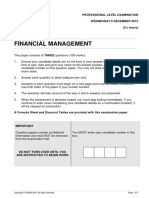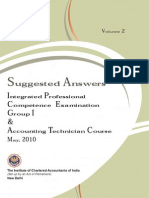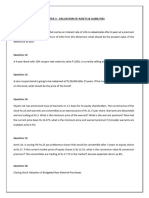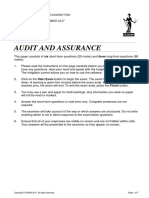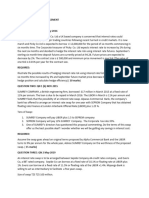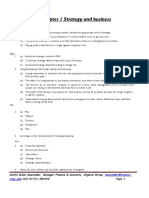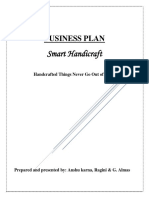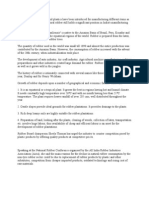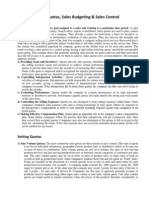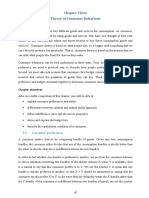PL S18 FM Web
PL S18 FM Web
Uploaded by
IQBAL MAHMUDCopyright:
Available Formats
PL S18 FM Web
PL S18 FM Web
Uploaded by
IQBAL MAHMUDOriginal Title
Copyright
Available Formats
Share this document
Did you find this document useful?
Is this content inappropriate?
Copyright:
Available Formats
PL S18 FM Web
PL S18 FM Web
Uploaded by
IQBAL MAHMUDCopyright:
Available Formats
PROFESSIONAL LEVEL EXAMINATION
WEDNESDAY 12 SEPTEMBER 2018
(2½ HOURS)
FINANCIAL MANAGEMENT
This exam consists of three questions (100 marks).
Marks breakdown
Question 1 35 marks
Question 2 35 marks
Question 3 30 marks
1. Please read the instructions on this page carefully before you begin your exam. If you
have any questions, raise your hand and speak with the invigilator before you begin.
2. The invigilator cannot advise you on how to use the software, but please alert them
immediately if you encounter any issues during the delivery of the exam. If you believe
that your performance has been affected by any issues which occurred, you must
request and complete a candidate incident report form at the end of the exam. This form
must be submitted as part of any subsequent special consideration application.
3. Click on the Start Exam button to begin the exam. The exam timer will begin to count
down. A warning is given five minutes before the exam ends. When the exam timer
reaches zero, the exam will end. To end the exam early, press the Finish button.
4. You may use a pen and paper for draft workings. Any information you write on paper
will not be read or marked.
5. The examiner will take account of the way in which answers are structured. Respond
directly to the exam question requirements. Do not include any content or opinion of a
personal nature. A student survey is provided post-exam for feedback purposes.
6. Ensure that all of your responses are visible on screen and are not hidden within cells.
Your answers will be presented to the examiner exactly as they appear on screen.
A Formulae Sheet and Discount Tables are provided with this exam.
Copyright © ICAEW 2018. All rights reserved.
Question 1
Assume that the current date is 31 August 2018
The Thomas Rumsey Group plc (Rumsey) is a UK company which was founded in 2001 and
has a financial year end of 31 August. Rumsey manufactures computer hardware and also
supplies information technology (IT) support services. Since its formation the group has
expanded via organic growth and the acquisition of other companies.
Snowdog Printers Ltd (Snowdog) is a UK company that manufactures computer printers.
Rumsey has owned 100% of Snowdog’s ordinary shares since 2009.
Snowdog’s sales and profits have fallen in each of the last two years. Rumsey’s board met in
July 2018 and decided to wind down Snowdog’s operations and that Snowdog will cease
trading in three years’ time, on 31 August 2021.
Following the July 2018 meeting, Snowdog’s directors informed the Rumsey board that they
would like to investigate a management buy-out (MBO) of 100% of Snowdog’s share capital.
You are an ICAEW Chartered Accountant and you work in Rumsey’s finance team. You have
been asked to provide guidance on the MBO for Rumsey’s board.
The Snowdog MBO was discussed at the Rumsey board meeting on 15 August 2018. Three
key issues discussed at that meeting are summarised below:
It was agreed that the buy-out price for Snowdog would be its economic value to Rumsey,
assuming that it remained in the group until 31 August 2021. The economic value would
be the expected net present value of Snowdog’s projected cash flows over the next three
years, discounted at Rumsey’s WACC. The forecast data for this calculation is shown
below.
One of Rumsey’s directors asked “Couldn’t we add a premium to the MBO price? The
cash flows are only estimates after all. I’m sure that we could inflate the cash inflows or
alter the WACC figure in our favour. Snowdog’s directors would be unaware of this and
they seem very keen to buy the company.”
Another director asked whether Shareholder Value Analysis (SVA) could be used as an
alternative to the expected NPV to calculate the value of Snowdog.
Forecast data
(1) Sales in the year to 31 August 2020 will be dependent on the level of sales in the year
to 31 August 2019 as shown in the table below:
y/e August 2019 y/e 31 August 2020
Sales (£m) Probability Sales (£m) Probability
5.0 0.6
7.0 0.7
4.0 0.4
4.0 0.4
4.5 0.3
3.0 0.6
Sales in the year to 31 August 2021 will be £2.5 million. The expected value of annual
sales is to be used in the NPV calculation.
Copyright © ICAEW 2018. All rights reserved. Page 2 of 7
(2) Variable costs will be 30% of sales.
(3) Fixed costs (including depreciation of £600,000 pa) will be £1.7 million pa.
(4) Closure costs on 31 August 2021 will be £600,000.
(5) All of the figures in (1) – (4) above are in 31 August 2018 prices. The inflation rate for
sales and costs is 2% pa.
(6) The tax written down value at 31 August 2018 of Snowdog’s plant and machinery is
£3.3 million. It is estimated that this will have a scrap value of £1.5 million (in 31 August
2021 prices) on 31 August 2021. The plant and machinery attracts 18% (reducing
balance) capital allowances in the year of expenditure and in every subsequent year of
ownership by the company, except the final year. In the final year, the difference
between the equipment’s written down value for tax purposes and its disposal proceeds
will be treated by the company either as:
a balancing allowance, if the disposal proceeds are less than the tax written down
value, or
a balancing charge, if the disposal proceeds are more than the tax written down
value.
(7) Snowdog’s working capital on 31 August 2018 totalled £1.8 million. It is planned to
reduce this by £0.2 million on 31 August 2019 and £0.3 million on 31 August 2020. The
outstanding balance will be released on 31 August 2021. All working capital figures are
given in money terms.
Other information
Corporation tax will be payable at the rate of 17% for the foreseeable future and tax will be
payable in the same year as the cash flows to which it relates.
Rumsey’s money WACC is 11% pa.
Requirements
1.1 Calculate the expected NPV of Snowdog’s money cash flows at 31 August 2018.
(18 marks)
1.2 Calculate the effect on this expected NPV if the scrap value of Snowdog’s plant and
machinery on 31 August 2021 is £1 million. (4 marks)
1.3 Comment on the ethical implications for you as an ICAEW Chartered Accountant of the
Rumsey director’s suggestion regarding the MBO premium. (3 marks)
1.4 Explain what is meant by the term ‘real options’ and identify for Rumsey’s board two
real options that could apply to Snowdog as alternatives to the MBO. (5 marks)
1.5 Outline the Shareholder Value Analysis (SVA) approach to company valuation,
identifying its advantages and disadvantages. (5 marks)
Total: 35 marks
Copyright © ICAEW 2018. All rights reserved. Page 3 of 7
Question 2
Assume that the current date is 1 September 2018
Heath Care plc (Heath) is a listed UK company that sells baby products. The company was
founded in 1995 and it has a financial year end of 31 August.
All of Heath’s customers are based in the UK. They order goods online and these are then
delivered by a national courier company from Heath’s central warehouse. Despite not having
any physical shops, Heath was initially very successful. However, in the past two years the
market for baby products has become much more competitive and the company’s market
share has fallen as a result. This has led to a 15% decline in the price of its ordinary shares.
You work in Heath’s finance team and have been asked to provide guidance for the
company’s board following its most recent meeting. At that meeting the following suggestions
were made by two of Heath’s directors:
Janine Barrowland – “We could establish a number of Heath shops across the UK. This
would give more visibility to our brand. I estimate it would cost us £10 million for ten
shops. I can see from the management accounts that we’ve not got sufficient cash to
make that sort of investment, but I see no reason why we shouldn’t borrow the £10
million. Interest rates are still very low and we could probably borrow it from our bank at
a maximum cost of 4% pa. Our WACC wouldn’t alter by much, which would make any
investment decision very straightforward.”
Chris Sinnott – “Why not invest in a completely different type of business? We know that
people in the UK are living longer and I know of an established care home business that
is for sale and it may well be a good investment for us.
There’s a steady net cash inflow and we’d own a number of valuable properties. Yes, it’s
risky, but diversification like this would be good for our investors as we’d be making
positive use of the portfolio effect.”
An extract from Heath’s balance sheet at 31 August 2018 is shown below:
£’000
Ordinary share capital (£1 shares) 6,300
Retained earnings (note 1) 2,520
9% Preference share capital (£1 shares) 750
4% Redeemable debentures (note 2) 680
5% Irredeemable debentures 1,240
11,490
Note 1
Earnings for the year to 31 August 2018 were £1,050,000 and an ordinary dividend of
£630,000 for the year to 31 August 2018 has been proposed.
Copyright © ICAEW 2018. All rights reserved. Page 4 of 7
Note 2
These debentures are redeemable at par on 1 September 2021.
The market prices of Heath’s long-term finance on 1 September 2018 are:
Ordinary shares £3.45/share (cum div)
Preference shares £1.62/share (cum div)
Redeemable debentures £103% (cum interest)
Irredeemable debentures £94% (ex interest)
Additional information
Heath’s equity beta 1.4
Expected risk free rate 3.35% pa
Expected return on the market 8.25% pa
You should assume that corporation tax will be payable at the rate of 17% for the
foreseeable future and tax will be payable in the same year as the cash flows to which it
relates.
Note: In the earnings retention model g = rb.
Requirements
2.1 Calculate Heath’s WACC on 1 September 2018 using:
(a) Gordon’s growth model (earnings retention model)
(17 marks)
(b) CAPM (3 marks)
2.2 Compare and contrast Gordon’s growth model with the CAPM as alternative means of
calculating the cost of equity. (5 marks)
2.3 Advise Heath’s directors whether they should use the existing WACC figure calculated
in part 2.1 above when appraising the investment suggested by Janine Barrowland.
Your advice should include specific reference to the use of the APV technique and the
circumstances under which it is applicable. (6 marks)
2.4 From the point of view of a shareholder, explain the portfolio effect and discuss the
validity of Chris Sinnott’s proposal that Heath should purchase a care home business.
(4 marks)
Total: 35 marks
Copyright © ICAEW 2018. All rights reserved. Page 5 of 7
Question 3
Assume that the current date is 1 September 2018
Eddyson Cordless Ltd (Eddyson) is a UK-based company that designs and manufactures
battery-powered home and garden appliances. It was formed in 2010 and an analysis of its
sales and purchases, by value, over the past 12 months shows the following:
UK Eurozone
Sales 96% 4%
Purchases of raw materials 74% 26%
Recently, a very large US electrical wholesale company, Timba Inc (Timba), placed an order
with Eddyson worth $2.3million. The goods will be exported to the US next week and Timba
will pay for them on 30 November 2018.
Eddyson’s board is considering whether it is worth hedging the foreign exchange rate risk
associated with the sale to Timba. Four possible strategies have been proposed:
Do not hedge
Use a forward contract
Use a money market hedge
Use sterling traded currency options
You work in Eddyson’s finance team and have been asked to provide calculations and
guidance for the board. You have collected the following information at the close of business
on
1 September 2018:
Spot exchange rate ($/£) 1.3655 – 1.3775
Three-month forward contract premium ($/£) 0.0060 – 0.0044
Arrangement fee for forward contract £0.30 per $100 converted
Sterling interest rate (borrowing) 5.6% pa
Sterling interest rate (lending) 4.6% pa
US dollar interest rate (borrowing) 4.0% pa
US dollar interest rate (lending) 3.2% pa
Sterling traded currency options (standard contract size £31,250) are priced as follows on
1 September 2018 (premiums are quoted in cents per £):
September November
2018 2018
contracts contracts
Exercise price ($/£) Calls Puts Calls Puts
1.351.08 2.36 1.99 3.70
Copyright © ICAEW 2018. All rights reserved. Page 6 of 7
Requirements
3.1 Calculate Eddyson’s net sterling receipt for each of the four proposed strategies under
consideration, assuming that on 30 November 2018 the spot exchange rate will be:
(a) $/£ 1.3240 – 1.3350
(b) $/£ 1.3935 – 1.4050
Note: Interest on option premiums should be ignored. (16 marks)
3.2 With reference to your calculations in 3.1 above, advise Eddyson’s board whether it
should hedge against movements in the value of the US dollar. (6 marks)
3.3 Explain, with relevant workings, why the three-month forward rate is expressed at a
premium to the spot rate on 1 September 2018. (5 marks)
3.4 Briefly discuss whether any future sales to Timba might expose Eddyson to economic
risk. (3 marks)
Total: 30 marks
Copyright © ICAEW 2018. All rights reserved. Page 7 of 7
You might also like
- Summary of Business - Strategy - Application - Level - Question - Bank - With Immediate AnswersDocument221 pagesSummary of Business - Strategy - Application - Level - Question - Bank - With Immediate AnswersIQBAL MAHMUDNo ratings yet
- June MockDocument15 pagesJune Mocklavanya vsNo ratings yet
- Audit and Assurance Exam March 2019Document9 pagesAudit and Assurance Exam March 2019KyleChanNo ratings yet
- Financial Management September 2013 Exam Paper ICAEWDocument8 pagesFinancial Management September 2013 Exam Paper ICAEWMuhammad Ziaul HaqueNo ratings yet
- F9 RM QuestionsDocument14 pagesF9 RM QuestionsImranRazaBozdar50% (2)
- PL FM M16 Exam PaperDocument7 pagesPL FM M16 Exam PaperIQBAL MAHMUDNo ratings yet
- Financial Management 2015 December QuestionDocument7 pagesFinancial Management 2015 December QuestionRakib AhmedNo ratings yet
- Accounting Theory and Current Issues PDFDocument5 pagesAccounting Theory and Current Issues PDFTahir MaqsoodNo ratings yet
- p1 Managerial Finance August 2017Document24 pagesp1 Managerial Finance August 2017ghulam murtazaNo ratings yet
- Icaew FMDocument16 pagesIcaew FMcima2k15No ratings yet
- HI5020 Tutorial Question Assignment 2 PDFDocument6 pagesHI5020 Tutorial Question Assignment 2 PDFshikha khanejaNo ratings yet
- Assignment BriefDocument9 pagesAssignment Briefhfayaaz2016No ratings yet
- AC3103 Seminar 2 Discussion Questions - Value Relevance, Measurement Approach, Fair ValueDocument3 pagesAC3103 Seminar 2 Discussion Questions - Value Relevance, Measurement Approach, Fair ValuehieveNo ratings yet
- Advanced Financial Management 3.3 IcagDocument23 pagesAdvanced Financial Management 3.3 IcagmohedNo ratings yet
- Acc100 Supp PDFDocument11 pagesAcc100 Supp PDFLebohang NgubaneNo ratings yet
- Associated British FoodsDocument16 pagesAssociated British FoodsMohd Shahbaz Husain100% (1)
- SA PCC-Group-I May 2010Document99 pagesSA PCC-Group-I May 2010NagarajuNeeliNo ratings yet
- Analysis of Financial Statements - Fall.2019.ExamDocument20 pagesAnalysis of Financial Statements - Fall.2019.Exam邹书妍No ratings yet
- PL FM S17 WebDocument7 pagesPL FM S17 WebIQBAL MAHMUDNo ratings yet
- Heriot-Watt University Accounting - December 2015 Section II Case Studies Case Study 1Document5 pagesHeriot-Watt University Accounting - December 2015 Section II Case Studies Case Study 1sanosyNo ratings yet
- FR Question Paper 81655199552Document3 pagesFR Question Paper 81655199552Nakul GoyalNo ratings yet
- Soal Akuntansi ManajemenDocument10 pagesSoal Akuntansi ManajemenIchwalsyah SyNo ratings yet
- 5 6188442313212035099Document19 pages5 6188442313212035099JamieNo ratings yet
- Lancaster University: January 2014 ExaminationsDocument6 pagesLancaster University: January 2014 Examinationswhaza7890% (1)
- Mock Questions PDFDocument6 pagesMock Questions PDFMadhuram SharmaNo ratings yet
- Question No. 1 Is Compulsory. Attempt Any Four Questions From The Remaining Five Questions. Working Notes Should Form Part of The AnswerDocument5 pagesQuestion No. 1 Is Compulsory. Attempt Any Four Questions From The Remaining Five Questions. Working Notes Should Form Part of The AnswerItikaa TiwariNo ratings yet
- MF Project Group 13 VIPDocument14 pagesMF Project Group 13 VIPVatsal SharmaNo ratings yet
- RTP CA Final Old Course Paper 2 Management Accounting and FinDocument38 pagesRTP CA Final Old Course Paper 2 Management Accounting and FinSajid AliNo ratings yet
- SPM BV - QuestionsDocument6 pagesSPM BV - Questionsytpremium230323032303No ratings yet
- Afm June 2016 QTDocument13 pagesAfm June 2016 QTBijay AgrawalNo ratings yet
- Planning, Materiality and Audit Risk Case StudiesDocument3 pagesPlanning, Materiality and Audit Risk Case Studiesksangiwa12No ratings yet
- A2 SBM N18 Questions FinalDocument15 pagesA2 SBM N18 Questions FinalMadalitso MbeweNo ratings yet
- Test AEKDocument30 pagesTest AEKSourav Mondal50% (2)
- PL AA S17 Exam PaperDocument7 pagesPL AA S17 Exam PaperIsavic Alsina100% (1)
- © The Institute of Chartered Accountants of IndiaDocument0 pages© The Institute of Chartered Accountants of IndiaamitmdeshpandeNo ratings yet
- FAR FinalDocument24 pagesFAR FinalSahan RodrigoNo ratings yet
- Bank Soal Uas Akm 2 Jul 2023Document4 pagesBank Soal Uas Akm 2 Jul 2023s130321047No ratings yet
- Interest Rate Risk ManagementDocument8 pagesInterest Rate Risk ManagementEdga WariobaNo ratings yet
- M8 PracticeDocument22 pagesM8 PracticeleeminleeNo ratings yet
- Fa May June - 2019Document5 pagesFa May June - 2019xodic49847No ratings yet
- Financial ManagementDocument3 pagesFinancial ManagementMRRYNIMAVATNo ratings yet
- P5 RM March 2016 Questions PDFDocument12 pagesP5 RM March 2016 Questions PDFavinesh13No ratings yet
- Afm Mms Individual Assignment Submission Deadline: 3pm On 22 August, 2013Document2 pagesAfm Mms Individual Assignment Submission Deadline: 3pm On 22 August, 2013Abhishek BangNo ratings yet
- Practice Case On ValuationDocument4 pagesPractice Case On ValuationSiwalik MishraNo ratings yet
- Exercise Ch3Document12 pagesExercise Ch3sreyneangsornn40No ratings yet
- Business Applications: Percentage, Base, and Rate Ratio and ProportionDocument23 pagesBusiness Applications: Percentage, Base, and Rate Ratio and ProportionMady PunsalanNo ratings yet
- Accounting I Nov 2019 Exam Final PaperDocument8 pagesAccounting I Nov 2019 Exam Final Paper2603803No ratings yet
- P7INT 2014 Jun QDocument10 pagesP7INT 2014 Jun QBipinNo ratings yet
- Finance II Mid-Term Exam 2020Document4 pagesFinance II Mid-Term Exam 2020Yash KalaNo ratings yet
- Homework Financial MNGTDocument3 pagesHomework Financial MNGTArka Narayan DashguptaNo ratings yet
- Question 1: Company Analysis (17 Marks Total) : Assignment 2Document5 pagesQuestion 1: Company Analysis (17 Marks Total) : Assignment 2Armeen Khan0% (1)
- 2.3 Paper 2.3 - Accounting For Business - 1Document6 pages2.3 Paper 2.3 - Accounting For Business - 1Himanshu SinghNo ratings yet
- 1.3 M1 - Dividends Question SetDocument3 pages1.3 M1 - Dividends Question Setshyla negiNo ratings yet
- Importanat Questions - Doc (FM)Document5 pagesImportanat Questions - Doc (FM)Ishika Singh ChNo ratings yet
- Required: Using These Data, Construct The December 31, Year 5 Balance Sheet For Your AnalysisDocument3 pagesRequired: Using These Data, Construct The December 31, Year 5 Balance Sheet For Your AnalysisJARED DARREN ONGNo ratings yet
- FT-2 Advanced Accounting-SolvedDocument21 pagesFT-2 Advanced Accounting-Solvedmohitnishadm11No ratings yet
- Financial Reporting: (Ind-AS 33, 34, 108, 19, 102)Document3 pagesFinancial Reporting: (Ind-AS 33, 34, 108, 19, 102)Dipika MalpaniNo ratings yet
- Pawn Shop Revenues World Summary: Market Values & Financials by CountryFrom EverandPawn Shop Revenues World Summary: Market Values & Financials by CountryNo ratings yet
- A Comparative Analysis of Tax Administration in Asia and the Pacific—Sixth EditionFrom EverandA Comparative Analysis of Tax Administration in Asia and the Pacific—Sixth EditionNo ratings yet
- Business Credit Institutions Miscellaneous Revenues World Summary: Market Values & Financials by CountryFrom EverandBusiness Credit Institutions Miscellaneous Revenues World Summary: Market Values & Financials by CountryNo ratings yet
- It Governance Technology-Chapter 01Document4 pagesIt Governance Technology-Chapter 01IQBAL MAHMUDNo ratings yet
- It Governance TechnologyDocument5 pagesIt Governance TechnologyIQBAL MAHMUDNo ratings yet
- Summary of Business Strategy Application Level - Self Test With Immediate AnswerDocument177 pagesSummary of Business Strategy Application Level - Self Test With Immediate AnswerIQBAL MAHMUDNo ratings yet
- Summary of Audit & Assurance Application Level - Self Test With Immediate AnswerDocument72 pagesSummary of Audit & Assurance Application Level - Self Test With Immediate AnswerIQBAL MAHMUDNo ratings yet
- Summary of Business Strategy Application Level Interactive Questions With Immediate AnswerDocument118 pagesSummary of Business Strategy Application Level Interactive Questions With Immediate AnswerIQBAL MAHMUDNo ratings yet
- Solution Tax Question (Application Level)Document6 pagesSolution Tax Question (Application Level)IQBAL MAHMUDNo ratings yet
- Summary of Audit & Assurance Application Level - Interactive Questions With Immediate AnswersDocument46 pagesSummary of Audit & Assurance Application Level - Interactive Questions With Immediate AnswersIQBAL MAHMUDNo ratings yet
- Summary of Audit & Assurance Application Level - Worked ExampleDocument22 pagesSummary of Audit & Assurance Application Level - Worked ExampleIQBAL MAHMUDNo ratings yet
- Ca Ipcc - ItDocument82 pagesCa Ipcc - ItIQBAL MAHMUDNo ratings yet
- Question - Analysis Audit and Assurance Application LevelDocument28 pagesQuestion - Analysis Audit and Assurance Application LevelIQBAL MAHMUDNo ratings yet
- PL FM S17 WebDocument7 pagesPL FM S17 WebIQBAL MAHMUDNo ratings yet
- PL M17 Financial ManagementDocument9 pagesPL M17 Financial ManagementIQBAL MAHMUDNo ratings yet
- Chapter-06 (Most Important)Document23 pagesChapter-06 (Most Important)IQBAL MAHMUDNo ratings yet
- Order #0002396: Professional - BST Item ListDocument1 pageOrder #0002396: Professional - BST Item ListIQBAL MAHMUDNo ratings yet
- PL FM D17 Student Mark PlanDocument11 pagesPL FM D17 Student Mark PlanIQBAL MAHMUDNo ratings yet
- Smart Handicraft: Business PlanDocument7 pagesSmart Handicraft: Business PlanM Maisam SultaniNo ratings yet
- Chapter 11 PDFDocument27 pagesChapter 11 PDFKumar SaketNo ratings yet
- Bagnol FSDocument55 pagesBagnol FSRosemarie EspinaNo ratings yet
- Reverse LogisticsDocument21 pagesReverse LogisticsParth V. PurohitNo ratings yet
- Financial Accounting Reviewer - Chapter 57Document7 pagesFinancial Accounting Reviewer - Chapter 57Coursehero Premium100% (1)
- Eric Stevanus - 2201756600 - LA28: 1. The Cost FunctionDocument2 pagesEric Stevanus - 2201756600 - LA28: 1. The Cost Functioneric stevanusNo ratings yet
- Rubber EssayDocument3 pagesRubber EssayRossayu MansorNo ratings yet
- Introduction To Strategic Management NotesDocument21 pagesIntroduction To Strategic Management NotesVineet KumarNo ratings yet
- Top 100 Chemical CompaniesDocument11 pagesTop 100 Chemical Companiestawhide_islamicNo ratings yet
- The 6 Pillars of Successful BusinessesDocument81 pagesThe 6 Pillars of Successful BusinessesJoshelle B. BanciloNo ratings yet
- Data Interpretation PO Mains PDF Set 10Document47 pagesData Interpretation PO Mains PDF Set 10SayantanNo ratings yet
- Sales Quotas, Budgeting & ControlDocument12 pagesSales Quotas, Budgeting & ControlAbhishek SisodiaNo ratings yet
- Invoice - 1447029373Document1 pageInvoice - 1447029373vijay mishraNo ratings yet
- Plant Location: A Lokeshwari 22N31E0014Document13 pagesPlant Location: A Lokeshwari 22N31E0014turpu poojithareddyNo ratings yet
- MonopolyDocument27 pagesMonopolyM M Al FuadNo ratings yet
- Chapter 5 - Depreciation: Engineering EconomicsDocument36 pagesChapter 5 - Depreciation: Engineering Economicslet it be100% (1)
- RedmrcDocument1 pageRedmrcHitesh PanigrahiNo ratings yet
- Corporate Gifts PO and Terms Condition Millennium Erectors CorporationDocument3 pagesCorporate Gifts PO and Terms Condition Millennium Erectors CorporationByron GuillermoNo ratings yet
- DepreciationDocument21 pagesDepreciationluxman_sharma1189No ratings yet
- Trial Final ExammDocument25 pagesTrial Final ExammTrần Ngọc Quỳnh ChiNo ratings yet
- 2020 T3 GSBS6410 Lecture Notes For Week 5 Market StructureDocument31 pages2020 T3 GSBS6410 Lecture Notes For Week 5 Market StructureRenu JhaNo ratings yet
- Financial and Economic Analysis of ProjectsDocument55 pagesFinancial and Economic Analysis of ProjectsCarmina Chrapkiewicz100% (1)
- A-C Assignment in PO (A & K)Document6 pagesA-C Assignment in PO (A & K)2414566No ratings yet
- Coast Artillery Journal - Jun 1937Document100 pagesCoast Artillery Journal - Jun 1937CAP History LibraryNo ratings yet
- Trend AnalysisDocument28 pagesTrend Analysisdiwakar0000000No ratings yet
- Bharat Forge PresentationDocument18 pagesBharat Forge PresentationAniket AkhNo ratings yet
- Chapter Three Theory of Consumer BehaviourDocument42 pagesChapter Three Theory of Consumer BehaviourkalehiwotkoneNo ratings yet
- 2625 - Inquiry FormDocument2 pages2625 - Inquiry FormErcan YilmazNo ratings yet
- Assignment Questions AreDocument4 pagesAssignment Questions AreRachit MittalNo ratings yet
- Kse - 30 Index Based On Free-Float: The Karachi Stock Exchange (Guarantee) LimitedDocument21 pagesKse - 30 Index Based On Free-Float: The Karachi Stock Exchange (Guarantee) LimitedJan Muhammad MemonNo ratings yet






